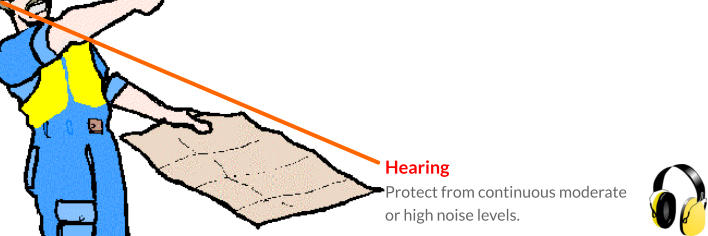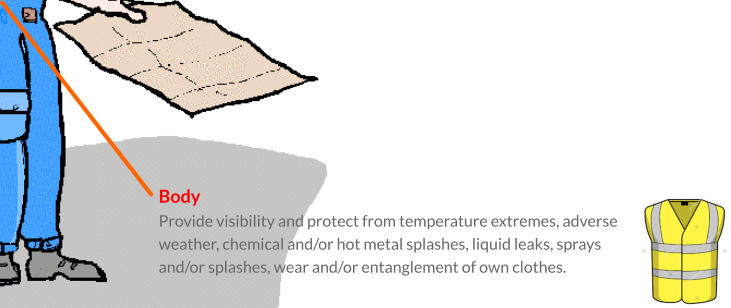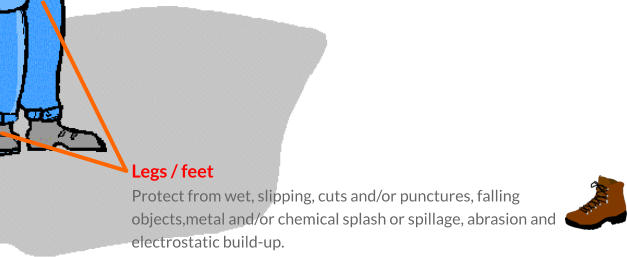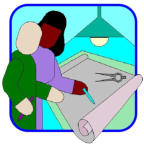Workplaces must be a safe place to be in, and without risk to health
The Workplace (Health, Safety and Welfare) Regulations place a duty on you to consider the workplace environment and provide basic facilities to make the workplace a safe and healthy place to be in. A good design and layout is essential and consideration should be given to known hazards. There must be enough space for people to do their jobs safely. Mark hazardous areas such as pits and platform edges with brightly coloured tape to warning people. Buildings must have sufficient fire resistance to allow safe evacuation if necessary. Doors and windows must be easy to open with viewing panels in doors so that when you open them you don't endanger anyone. Appropriate safety signs should be displayed in the workplace. It is important to keep the workplace neat and tidy. An action as simple as removing rubbish to proper containers can help reduce the risk of fire. Always keep gangways and fire exits clear. Good ventilation, whether natural or artificial, and good lighting levels greatly improves working conditions and reduces fatigue levels. As far as possible, the temperature in the workplace should be kept at a comfortable level. Every workplace should have welfare facilities adequate for the number of people who work there and the type of work activity undertaken.Every organisation must assess the hazards and risks that arise from its
work activities
The Management of Health and Safety at Work Regulations impose a specific duty to carry out a suitable and sufficient assessment of all risks to the health and safety of employees and others, arising at or from a work activity. There are specific provisions requiring a risk assessment to be carried out where there are risks to new or expectant mothers or young persons. The employer is under a general duty to reduce risks, so far as is reasonably practicable. A hazard is generally considered as something with the inherent potential to cause harm or injury. Risk is the likelihood of harm or injury arising from a hazard. See what you can spot in the ‘test yourself’ section. To carry out a risk assessment you have to assess the hazards and risks to yourself or to other persons, including the public; arising from the work and the workplace in general. When preparing the assessment, look at: • Key health and safety risks that will be encountered; • Basic health, safety and welfare requirements for the work; • Hazards arising from work methods or products to be used; • The physical abilities of the individuals who will do the work; • Specific training, instruction or information, which may be required Take account of all of the hazards and the competence of the workforce and whether it includes groups of people who may be especially at risk e.g. young and/or inexperienced people. Always review the Risk Assessment following any accident / incident relating to the activity.Workplaces must be safe place to be in, and without risk to health
The Workplace (Health, Safety and Welfare) Regulations place a duty on you to consider the workplace environment and provide basic facilities to make the workplace a safe and healthy place to be in. A good design and layout is essential and consideration should be given to known hazards. There must be enough space for people to do their jobs safely. Mark hazardous areas such as pits and platform edges with brightly coloured tape to warning people. Buildings must have sufficient fire resistance to allow safe evacuation if necessary. Doors and windows must be easy to open with viewing panels in doors so that when you open them you don't endanger anyone. Appropriate safety signs should be displayed in the workplace. It is important to keep the workplace neat and tidy. An action as simple as removing rubbish to proper containers can help reduce the risk of fire. Always keep gangways and fire exits clear. Good ventilation, whether natural or artificial, and good lighting levels greatly improves working conditions and reduces fatigue levels. As far as possible, the temperature in the workplace should be kept at a comfortable level. Every workplace should have welfare facilities adequate for the number of people who work there and the type of work activity undertaken.People must be aware of risks and the workplace precautions where
they are working
New employees or those who have been transferred from other operations, must be informed of all the relevant health and safety matters, risk control systems and workplace precautions that are particular to their work and/or their workplace. This should include instruction and training about machinery, articles and/or substances for use at work and/or risks relating to the workplace. Get to know those who work with or for you, by taking an interest in their competencies and their future development. Understanding people in this way will achieve greater safety and efficiency and will reap benefits in all areas. Make sure that employees always look at the cable and plug on electrically operated portable work equipment before they use it, and make sure that it has been P.A.T. tested recently. They should check that the cable and plug are free of defects; they are suitable for the duty required and are safe to use. Do not allow them to use equipment if it has a damaged cable or plug. Make sure that the correct type of socket is used. Never allow work to be done on any equipment and/or services unless there is a suitable means of isolating it from all its sources of energy. This means establishing a break in the energy supply and ensuring that inadvertent reconnection is not possible by using a padlock to lock it off. This may include electricity, hydraulic, high-pressure water or steam systems. If more than one person is doing work on isolated equipment, they must use a locking device with multiple locks and keys; with each person having their own lock and key.Raise heath and safety standards in the workplace by offering positive guidance, and motiv-
ating people by checking as the work is done. In this way health and safety will reach and
maintain an acceptable standard. A high standard is in everyone’s interest.
Workplace precautions are designed to reduce identified risks to an ac-
ceptable level
A wide range of workplace precautions are available, some more effective than others. Typical workplace precautions include machinery guards, personal protective equipment (PPE) and safe systems of work. The most appropriate workplace precautions for any activity are decided by applying the following priorities: • if possible avoiding the risk altogether • where possible combating the risks at source • giving priority to measures that protect the whole workplace • wherever possible, adapt the work to the individual • taking advantage of technological and technical progress • using personal protective equipment (PPE) to minimising risk is considered a last resort In many instances, effective control of significant risks will only be achieved by implementing a proper method statement and/or a permit to work system that is appropriate to the task. Where a permit system is used, it must be followed.Safety signs give important messages and help to protect you
When you see a safety sign, always follow the information that it gives you
Safety Signs are one of the main means of communicating health and safety information
They must be provided if there is a significant risk that can't be avoided or controlled in any other way, such as through safe systems of work or engineering controls. This applies to all places and activities where people are employed, or where other people have access. However, there is no need to provide safety signs if they don't help reduce the risk or if the risk isn't significant.Personal Protective Equipment (PPE) must be used when there are risks
to health and safety that cannot be adequately controlled in other ways
The Personal Protective Equipment at Work Regulations defines PPE as “all equipment (including clothing affording protection against weather), which is intended to be worn or held by a person at work and which protects him against one or more risks to his health and safety”. The main requirement of the regulations is that PPE is supplied and used whenever there are risks to health and safety that cannot be adequately controlled in other ways. Because PPE may not be used properly, it should always be considered as the last resort and only used when other precautions cannot adequately reduce the risk of injury. Test yourself on the following example to see if you can decide what PPE is required. To allow the right type of PPE to be chosen, the different hazards in the workplace need to be considered carefully. The following factors should be considered: • is it appropriated for the risks involved and the conditions at the place of work? • does it prevent or adequately control the risk, without increasing the overall risk? • can it be adjusted to fit the wearer correctly? • has the state of health of those who will be wearing it been taken into account? • what is the needs of the job and the demands on the wearer? • if more than one item of PPE is being worn, are they compatible? Make sure that the wearer is aware of why PPE is needed, when it is to be used, repaired or replaced and its limitations. Instruct, train and supervise its use. ask are able to provide guidance on appropriate PPE for a range of regular work activitiesWhat personal protective equipment (PPE) does this person need?
- move your pointing device around his body to find outIf you work in, or have to carry out work in, an existing building, particu-
larly one built or refurbished before 1980, treat any insulation or insulat-
ing board, etc., as asbestos and follow this guidance
Breathing in air containing asbestos fibres can lead to asbestos-related diseases, mainly cancers of the lungs and chest lining. Asbestos is only a risk to health if asbestos fibres are released into the air and breathed in. Some asbestos containing materials are more vulnerable to damage and more likely to give off fibres than others. In general, the materials that contain a high percentage of asbestos are more easily damaged. The list below is roughly in order of ease of fibre release. • Sprayed asbestos and asbestos loose packing - generally used as fire breaks in ceiling voids; • Moulded or performed lagging - generally used in thermal insulation of pipes and boilers; • Sprayed asbestos - generally used as fire protection in ducts, firebreaks, panels, partitions, soffit it boards, ceiling panels and around structural steel work; • Insulating boards used for fire protection, thermal insulation, partitioning and ducts; • Some ceiling tiles; • Millboard, paper and paper products used for insulation of electrical equipment. Asbestos paper has also been used as a fireproof facing on wood fibreboard; • Asbestos cement products, which can be fully or semi-compressed into flat or corrugated sheets. Corrugated sheets are largely used as roofing and wall cladding. Other asbestos cement products include gutters, rainwater pipes and water tanks; • Certain textured coatings; • Bitumen roofing material; and • Vinyl or thermoplastic floor tiles.The Control of Asbestos at Work Regulations require you to manage the risk from asbestos.
Any work that is unfamiliar should be regarded as potentially of high risk
Carrying out a comprehensive Risk Assessment will show if the task is within your capabilities and resources. If there is any doubt, seek professional advice about the work. Do not allow anybody to undertake any work that may be a risk to themselves, or to others, until they have been trained and have satisfied a competent person of their ability to perform the work safely and efficiently. Some work is obviously of a much higher risk. For example, work that is carried out at high level, or on a roof, is usually considered to be a high risk activity where special precautions are needed. Likewise, working in a confined space requires special attention. A confined space can be any space that is enclosed, where there is a risk of death or serious injury from hazardous substances or dangerous conditions, e.g. lack of oxygen, poisoning, explosion or fire. The handling and storing of certain types of chemicals may also present a high risk to the person doing the task and may cause damage to the environment if spilt.







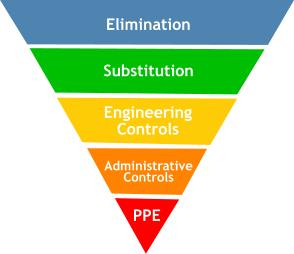

Least
effective
Most
effective


Some confined spaces are easy to
identify, e.g. enclosures with limited
openings:
•
storage tanks;
•
silos;
•
reaction vessels;
•
enclosed drains;
•
sewers
Others are less obvious, but can be equally
dangerous, for example:
•
open-topped chambers;
•
vats;
•
combustion chambers in furnaces, etc;
•
ductwork;
•
unventilated or poorly ventilated rooms.
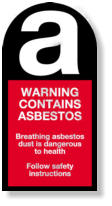








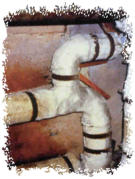
Prohibitions signs are round in shape and have a black
pictogram on a white background. They have a red
edging and a red diagonal line through the pictogram.
For example, the ‘no smoking’ signs, which you will see
in most work places, are a common prohibition sign.
The sign on the right means ‘No entry for people on
foot’, or ‘Don’t walk here’.
Prohibition signs
Danger, alarm - stop
Prohibition signs tell
you ‘Do not’



General
safety


























